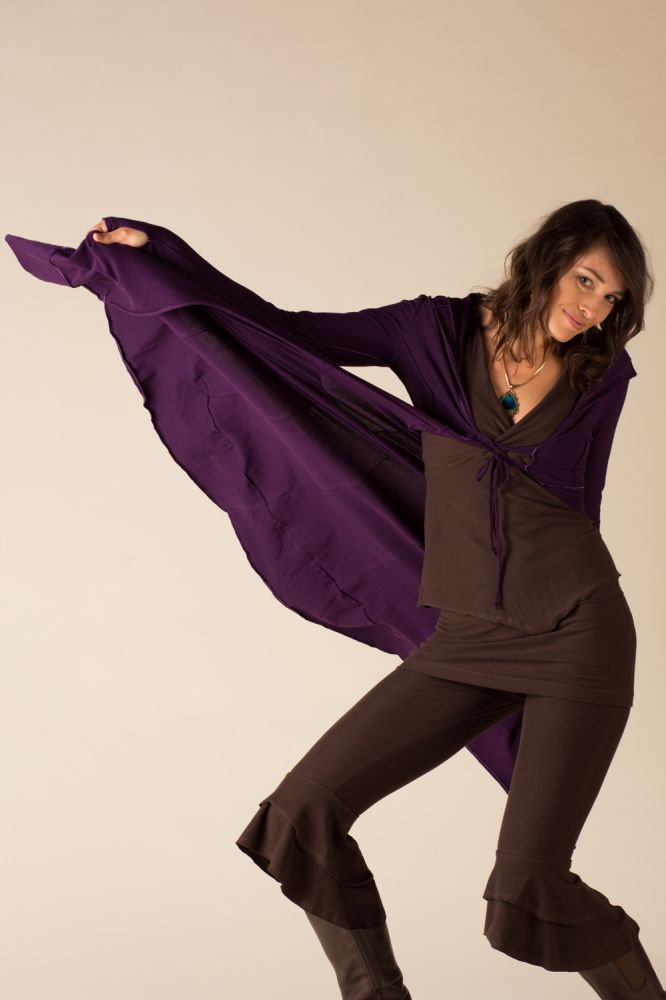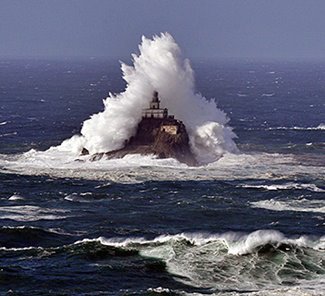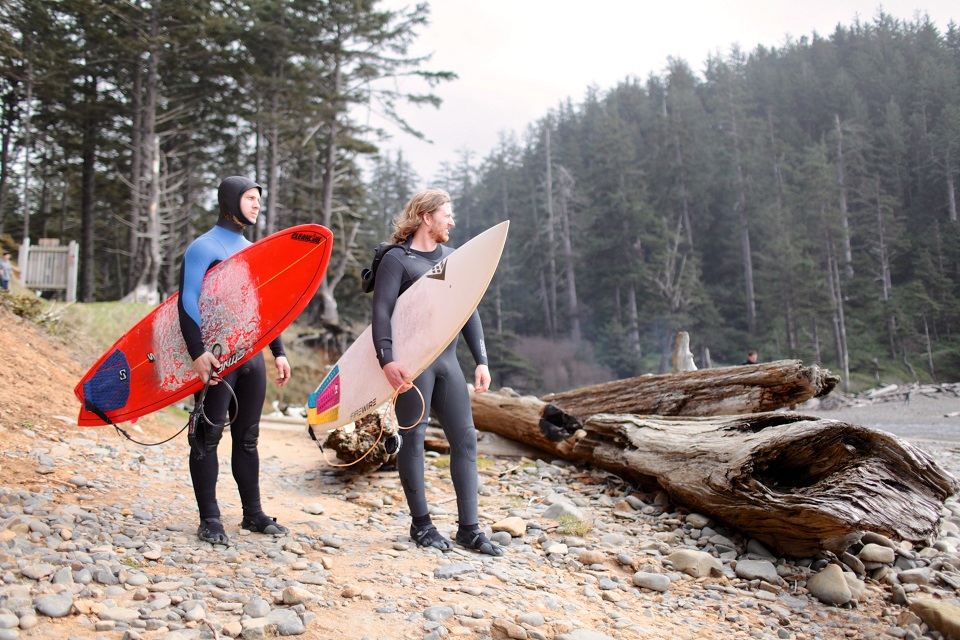written by Anna Bird | photos by Brown W. Cannon III
A seemingly normal barn on the outskirts of Bend is home to a couple horses, tack for the family’s small farm and an upstairs art gallery and studio—where the barn takes on a new life. The gallery and studio space is modern, bright, and open, with clean white walls, a high ceiling, two large windows on each end and a whitewashed wood floor.
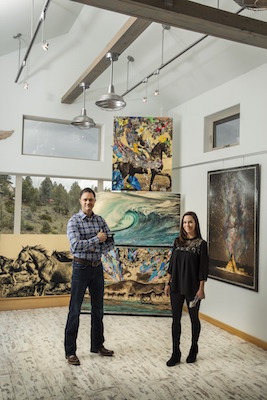
Brown Cannon and KC Lockrem are brother and sister. Their vastly different personalities and careers have led them here to Lockrem’s barn studio, surrounded by the works they have created for their first collaboration, “Golden.” The mixed-media pieces blend striking imagery of the Old West and ocean life with layers of whimsical color—a colorful representation of their contrasting personalities and diverse upbringing. Growing up in Denver, they spent their summers on a ranch in Fort Lupton where they rode horses, dug in the dirt and gathered chicken eggs. They spent many holiday breaks with family who lived in Hawaii, and every year they would travel somewhere new with their intrepid parents.
Their dad was the owner of Cannon Land Company, and a talented potter and photographer in his free time. Their mom was a social worker with an eye for painting and photography. They had a darkroom and wood shop in their house, cultivating the creative talents of a future travel photographer and mixed-media painter. While Cannon always had a camera in his hand learning photography, Lockrem had other interests. “My parents graciously made a dance studio and turned a little closet into a painting studio for me,” said Lockrem. “Probably because I was messing with the [dark room] chemicals.”
“Or because you weren’t interested in hanging out in the dark,” Cannon offered.
“Exactly!” said Lockrem. “I would take the mat board for all your photography, and I would color on them and paint them and make them into bookmarks.”
Cannon was influenced by Denver’s business-minded culture and went to Connecticut College, where he majored in art and economics, intending one day to go to medical school. After four years, it was a pinhole camera demonstration in a chemistry class that altered his course. “One of the realizations I had at the end of that, and what made it easier for me to make that transition, was realizing that, for me, there’s art in everything and there’s science in everything,” Cannon said of his transition to the Art Center College of Design in Pasadena. “There’s artistry in being a great surgeon, and there’s science in order to make a beautiful image.”
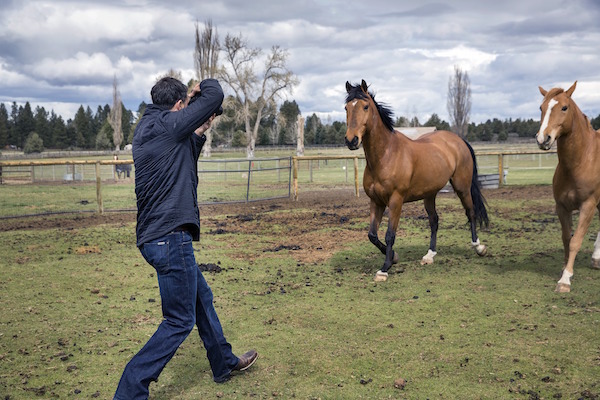
Lockrem was set on becoming a ballerina and spent a summer in high school in a Boston ballet program. After sustaining a knee injury skiing, she could no longer dance point, so the next summer she went to Rhode Island School of Design to study art. Soon she was on a path to be- coming a studio artist, first going to the University of Arizona so she could also participate on the rodeo team. Not satisfied with the art program, she went to the Chicago Art Institute for a year, and with encouragement from a teacher, went on to New York City to attend the School of Visual Arts. She received a BFA in painting in 1996, though her work has been shown in galleries and museums across the country since 1991.
“I think if I would have gone right from Denver to New York, I would have been overwhelmed, so I think that’s why I took those baby steps along the way,” Lockrem said.
With discipline and precision, Cannon has captured remarkable pictures while working as a travel photographer for Travel & Leisure, Condé Nast, Sunset, Outside and Audubon. When he ran the New York Marathon in 1998, he took a camera and made a flipbook of one shot per mile. He sent the book to those he had met at the marathon, and Travel & Leisure sent him to New Zealand for his first travel assignment. He has trotted the globe to the Galapagos Islands— where he found flamingos and seahorses, Indonesia, Africa and more. His North American interests harken back to the summers he spent with his family in Fort Lupton—the Old West, big skies, galloping horses and gritty cowboys.
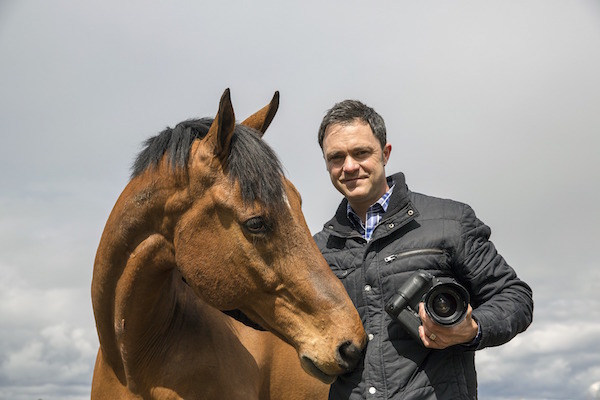
In a piece created by the siblings, a man extends the lasso of his rope. He’s a California cowboy and one of the original “Marlboro” men. His eyes are staring intensely toward his target, his brow determined. Arrowheads, stars, and diamonds in brilliant blues, oranges, greens and reds explode from his gloved hand, following the movement of the lasso. In another, a group of horses stampede through the Wyoming plains; a field of colorful horizontal stripes covers half the sky.
Cannon’s gift is being able to take in the minutiae of the moment to capture the essence of a story. A keen business sense has allowed him to make a good living from his photography, expanding his platforms to take advantage of the digital age of storytell- ing. Lockrem’s free spirit, introspection, and admiration for the past give her the ability to create layered narratives in her paintings and mixed media works. Her unfettered optimism comes alive through vibrant colors in her work. She feels a genuine connection to most living things—including her farm with goats, pigs, chickens, miniature horses, regular horses, donkeys, dogs and bunnies.
The collaboration, combining two tremendously different approaches and personalities of a photographer and painter, happened organically.
Cannon bought a large format printer to start printing his own images, and called Lockrem to come see it. Nostalgic for the darkroom, he was trying out different toners and papers with the printer when he found Moon Glow, a gold-flecked paper that gave his photos gritty, metallic gold tones. When Lockrem saw the paper, the two talked about the idea of collaborating. Before she left, they had two large prints of Cannon’s photos, and the wheels of “Golden” were set in motion. That was February 2014.
Cannon began giving his images to Lockrem, who would ask him to scan pennies, wishbones and her daughter’s Breyer horse collection. He abided.
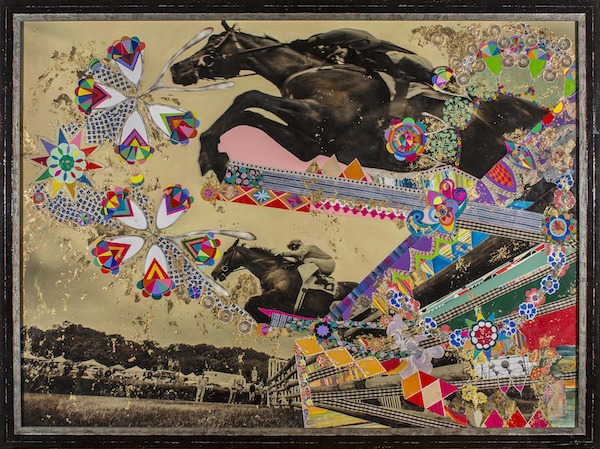
“When I bring these home, they’re gorgeous, they’re glorious, they’re perfect, there’s nothing you would ever change or want to do to these,” Lockrem said. Sometimes she has to work up the courage. “When I can let go, and also know that my brother has enough faith in me that he would actually let me take these …”
She described her creative process as a “symphony or a melody,” flowing out from her past, her spirituality, her love for nature and all things bright and beautiful. She accentuates the movement and energy in each photo, sometimes starting from the story behind the image or simply visualizing her own memories. In “Lucky Penny,” a Texan woman sits atop her horse, appearing stoic and powerful. “She’s the type of person who chooses to do something and ultimately becomes pretty much the best at it,” Cannon said. “She is a helicopter pilot, she flies planes now, yet she decided she wanted to learn dressage and be- came an international champion.”
In that photo, Lockrem saw her grandmother, who trained polo ponies and loved plumerias and hibiscus. She painted an elegant plumeria atop the woman’s head and a hibiscus on the horse’s.
“That’s how they transcend the typical experience of just looking at a photographic image to something that’s more layered,” Cannon said. “There isn’t one painting in here that’s just a single memory slapped down on canvas.”


